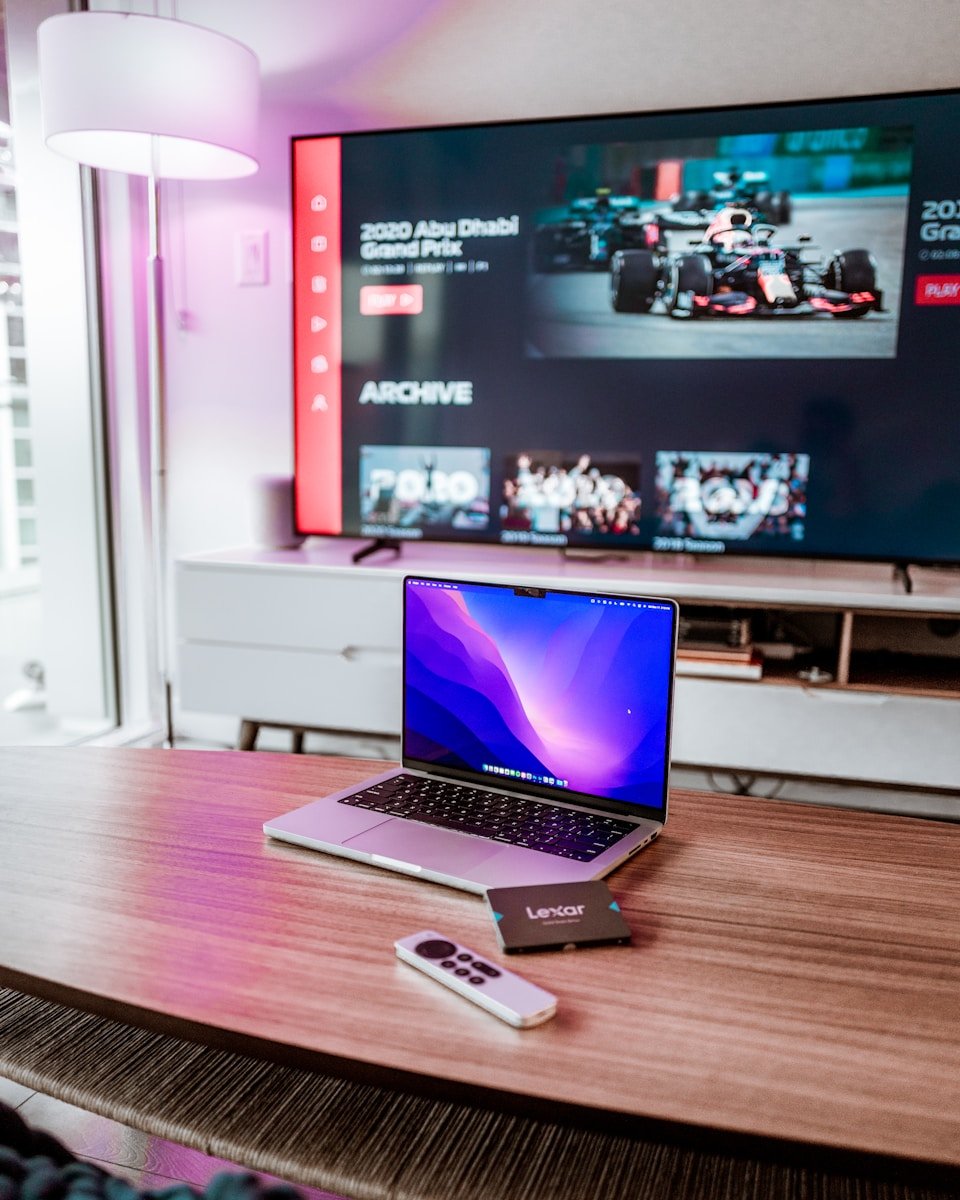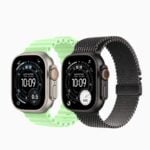Watching movies or playing games on a bigger screen makes the experience so much better. Connecting your MacBook to a TV gives you that big-screen advantage without needing to buy a new device. You can connect a MacBook to a TV either with an HDMI cable or wirelessly using AirPlay, depending on what equipment you already have.
Modern MacBooks might need an adapter since they often have only USB-C ports. If you have a newer TV, you might be able to connect wirelessly using AirPlay without any cables at all. For older TVs, a simple HDMI cable connection works best and gives you a stable, high-quality picture.
Option 1: Connect with a Cable (HDMI or USB‑C)
What You’ll Need
- A TV with an HDMI port
- An HDMI cable
- A USB‑C to HDMI adapter (if your MacBook only has USB‑C/Thunderbolt ports)
Steps
- Turn on your TV and select the correct HDMI input.
- Plug one end of the HDMI cable into your TV.
- Connect the other end to your MacBook (directly or via an adapter).
- On your MacBook, go to:
- Apple menu → System Settings → Displays
- Your TV should appear as a new display.
- Choose whether to:
- Mirror Display (show the same screen on both)
- Use as Extended Display (treat TV as extra screen space).
Option 2: Connect Wirelessly with AirPlay
Requirements
- A MacBook running macOS Mountain Lion or later
- An Apple TV or a smart TV that supports AirPlay 2
- Both devices connected to the same Wi‑Fi network
Steps
- Turn on your TV and make sure AirPlay is enabled.
- On your MacBook, click the Control Center icon (top right of menu bar).
- Select Screen Mirroring.
- Choose your Apple TV or AirPlay‑enabled TV from the list.
- Enter the AirPlay code shown on your TV (if prompted).
Troubleshooting Tips
- No signal on TV? Double‑check the HDMI input source.
- Laggy AirPlay? Move closer to the Wi‑Fi router or use a wired connection.
- No sound? Go to System Settings → Sound → Output and select your TV.
✅ That’s it! You can now enjoy movies, presentations, or music from your MacBook on a bigger screen.
Key Takeaways
- MacBooks can connect to TVs using either HDMI cables or wireless AirPlay methods.
- Newer MacBook models need a USB-C to HDMI adapter for wired connections to most TVs.
- Screen mirroring lets you display exactly what’s on your Mac screen or use your TV as a second display.
Understanding Connection Types
Connecting your MacBook to a TV requires choosing the right cable and port. Modern Macs offer several connection options, each with specific capabilities for video and audio transfer.
HDMI and Thunderbolt Explained
The HDMI port is the most common way to connect a MacBook to a TV. It carries both high-definition video and audio through a single cable. Older MacBook Pro models had HDMI ports built in, while newer models need adapters.
Thunderbolt is Apple’s high-speed connection technology. It has evolved through several versions:
- Thunderbolt 2: Uses a Mini DisplayPort connector and supports 4K video
- Thunderbolt 3 & 4: Use USB-C shaped connectors but offer faster speeds than standard USB-C
Thunderbolt connections can handle up to 40 Gbps data transfer, making them perfect for high-resolution displays. They can connect to TVs with the right adapter, usually converting to HDMI.
To use either connection, plug one end into your Mac and the other into your TV. Then select the correct input on your TV remote.
Differences Between USB-C and Thunderbolt
USB-C and Thunderbolt ports look identical, but they’re not the same. Here’s how they differ:
USB-C ports can:
- Transfer data at up to 10 Gbps (standard USB 3.1)
- Deliver power to charge devices
- Send video signals to displays
Thunderbolt 3/4 ports offer everything USB-C does, plus:
- Much faster data speeds (up to 40 Gbps)
- Support for multiple 4K displays or a single 8K display
- Better daisy-chaining capability for multiple devices
MacBooks with USB-C ports can connect to TVs using USB-C to HDMI adapters. The image quality depends on the adapter and cable quality. Not all USB-C ports support video output, so check your specific Mac model.
Alternative: DVI Connections
DVI (Digital Visual Interface) is an older connection type still found on some displays. It only carries video signals—no audio. This means you’ll need a separate solution for sound.
For Macs without DVI ports, you’ll need:
- A Mini DisplayPort to DVI adapter (for older Macs)
- A USB-C to DVI adapter (for newer Macs)
DVI comes in different versions:
- DVI-D (digital only)
- DVI-I (digital and analog)
- DVI-A (analog only)
Most MacBooks will need the DVI-D or DVI-I connector type. When using DVI, you’ll need to connect audio separately through a headphone jack to your TV or speakers.
While not as convenient as HDMI or Thunderbolt, DVI still delivers good video quality up to 1920×1200 resolution. It’s worth considering if your TV has a DVI input but lacks HDMI.
Preparing Your MacBook
Before connecting your MacBook to a TV, you need to make sure your device is properly set up. This includes checking your ports, updating your system, and adjusting your display settings for the best viewing experience.
Checking Hardware Compatibility
First, identify which ports your MacBook has. Newer MacBook models have USB-C/Thunderbolt 3 or 4 ports, while older models might have Thunderbolt 2 or HDMI ports.
For MacBooks with only USB-C ports, you’ll need a USB-C to HDMI adapter to connect to most TVs. These adapters are available from Apple or third-party manufacturers.
If your MacBook has a Thunderbolt 2 port (looks like a Mini DisplayPort), you’ll need a Thunderbolt to HDMI adapter instead.
Some older MacBook Pro models come with an HDMI port built-in, allowing for direct connection with a standard HDMI cable.
Check your TV’s available ports too. Most modern TVs have multiple HDMI inputs, but older TVs might require different adapters like VGA or DVI.
Updating MacOS
Make sure your MacBook runs the latest version of MacOS for the best compatibility and features. To check for updates:
- Click the Apple menu in the top-left corner
- Select System Settings (or System Preferences in older versions)
- Click on General > Software Update
- If updates are available, click Update Now
Newer MacOS versions offer improved AirPlay functionality, which allows wireless connections to compatible smart TVs without cables.
The latest updates also fix bugs that might interfere with external displays and improve overall performance when connecting to TVs.
Restart your MacBook after updating to ensure all changes take effect properly.
Adjusting Display Settings
Once connected, you’ll need to adjust your display settings for optimal viewing:
- Go to Apple menu > System Settings > Displays
- Choose between Mirror or Extend modes:
- Mirror: Shows the same content on both screens
- Extend: Uses the TV as an additional screen
You can customize the resolution by selecting the Scaled option and choosing a resolution that works best for your TV.
For the best picture quality, match the resolution to your TV’s native resolution (usually 1080p or 4K).
If text appears too small on your TV, adjust the scaling settings or increase the text size in your MacBook’s accessibility settings.
For video playback, you might need to adjust refresh rates to match your content (usually 60Hz for most videos).
Choosing the Right Cable or Adapter
Connecting your MacBook to a TV requires selecting the appropriate cable or adapter based on your specific MacBook model and TV inputs. The right connection ensures you get the best quality display and audio transfer possible.
HDMI Cables for MacBook
The simplest way to connect newer MacBooks to a TV is with a USB-C to HDMI cable. This single cable handles both video and audio signals, making setup quick and easy.
For the best performance, look for these features:
- HDMI 2.1 compatibility for 4K video at 60Hz
- High-speed rating for better picture quality
- Length appropriate for your setup (3-6 feet is typical)
Older MacBooks with built-in HDMI ports can connect directly using a standard HDMI cable. Make sure the cable is rated for the resolution you need. Some TVs may require specific HDMI ports for 4K content, usually labeled on the TV.
Adapters for Different MacBook Models
MacBook models have different ports that require specific adapters:
For MacBook Air M2:
- USB-C to HDMI adapter plus HDMI cable
- Thunderbolt 3 to HDMI multiport adapter (includes extra ports)
For older MacBooks with Mini DisplayPort:
- Mini DisplayPort to HDMI adapter (ensure it supports both audio and video)
- Mini DisplayPort to DVI adapter (for older TVs)
Budget-friendly options include basic USB-C to HDMI cables starting around $15-20. Premium multi-port adapters cost $40-80 but offer additional connectivity options like USB ports and power pass-through.
Wired Connections Setup
Connecting your MacBook to a TV with cables offers a reliable and high-quality viewing experience. Physical connections typically provide better resolution and less lag than wireless options.
Connecting HDMI to MacBook
Most TVs have HDMI ports, making this the simplest wired connection method. For newer MacBooks with USB-C ports, you’ll need an adapter to connect to your TV’s HDMI port.
First, get the right equipment. MacBooks released after 2016 require a USB-C to HDMI adapter or a docking station with HDMI output. Older MacBooks may have a built-in HDMI port or need a Thunderbolt to HDMI adapter.
Next, connect one end of the HDMI cable to your TV’s HDMI port. Then connect the other end to your MacBook or adapter. Make sure both devices are powered on.
On your Mac, click the Apple menu and select “System Preferences,” then “Displays.” Here you can adjust resolution, arrangement, and mirroring options.
Securing Connections
Loose connections between your MacBook and TV can cause display problems or signal loss. Taking time to secure these connections will ensure a better viewing experience.
Place your laptop on a stable surface near your TV to prevent cable strain. The ideal distance between your Mac and TV should be shorter than your cable length to avoid pulling.
Use cable management tools like clips or Velcro ties to organize cables and prevent accidental disconnections. This keeps your setup neat and reduces tripping hazards.
For MacBooks with docking stations like the Kensington SD5780T, ensure the dock is firmly connected to both your Mac and TV. Check that all plugs fit snugly into their ports.
If you experience signal issues, try gently wiggling connections to identify loose points. Sometimes simply unplugging and reinserting cables solves many connection problems.
Wireless Connections via AirPlay
AirPlay offers a cable-free way to connect your MacBook to your TV with just a few clicks. This technology lets you stream videos, share photos, or mirror your entire screen wirelessly.
Setting Up Apple AirPlay
To use AirPlay, make sure both your Mac and TV device are connected to the same Wi-Fi network. This is the most important step for a successful connection.
For Apple TV users, the setup is straightforward. Your Apple TV should automatically appear as an available device on your Mac. If you’re using a Mac running recent operating systems, simply click on the Control Center icon in the menu bar (located in the top-right corner).
Look for the “Screen Mirroring” option and select your Apple TV or AirPlay-compatible device from the list. Your Mac screen will then display on your TV.
You can adjust settings like resolution by clicking on the AirPlay icon in the menu bar while streaming. This lets you optimize the display for your specific TV.
Using AirPlay with Smart TV
Many newer smart TVs come with AirPlay compatibility built-in, eliminating the need for an Apple TV device. These TVs support AirPlay 2, Apple’s enhanced streaming protocol.
To connect your Mac to a compatible smart TV, first ensure both devices are on the same Wi-Fi network. Then click the AirPlay icon in your Mac’s menu bar or in the playback controls of apps like Safari or QuickTime.
Select your smart TV from the device list that appears. Your Mac content will begin streaming to your TV. For video content specifically, find the video you want to watch, click the AirPlay icon in the player controls, and select your TV.
You can stream specific content while still using your Mac for other tasks, or mirror your entire screen. To stop streaming, simply click the AirPlay icon again and select “Disconnect.”
Troubleshooting Common Issues
Even with the right cables and settings, you might face some problems when connecting your MacBook to a TV. Here are solutions for the most common connection issues you might encounter.
Resolving HDMI Signal Problems
If your TV doesn’t detect your MacBook after connecting via HDMI, try these fixes:
Check your cable connection – Make sure the HDMI cable is firmly plugged in at both ends.
Try a different HDMI port on your TV. Some ports may work better than others.
Restart both devices – Turn off your MacBook and TV, then turn them back on.
Verify display settings on your Mac by going to System Preferences > Displays and checking if your TV appears.
If your Mac still doesn’t detect the TV, hold down the Option key while clicking on System Information, then check Graphics/Displays to see if your TV is recognized.
Sometimes the display may flicker or disconnect randomly. This often happens due to cable quality issues. Using a high-quality HDMI cable can fix this problem.
Fixing AirPlay Connectivity
AirPlay problems are usually related to network issues or device compatibility.
First, make sure your Mac and Apple TV are on the same Wi-Fi network. Different networks will prevent connection.
If AirPlay isn’t working:
- Check your Wi-Fi signal strength – move closer to your router if needed
- Restart your router to clear any network issues
- Update your MacBook’s software to the latest version
- Restart your Apple TV by unplugging it for 10 seconds
For persistent problems, try turning AirPlay off and on again. On your Mac, click the Control Center icon in the menu bar, select Screen Mirroring, and toggle it off and on.
Some older TVs might need a software update to work properly with newer Macs. Check your TV manufacturer’s website for the latest firmware updates.
Third-Party Screen Mirroring Software
When you can’t use AirPlay, third-party solutions offer reliable ways to connect your MacBook to your TV. These alternatives range from hardware dongles to specialized software applications.
Using Chromecast with MacBook
Google’s Chromecast is a popular option for screen sharing from Mac to TV. To get started, you’ll need both devices connected to the same Wi-Fi network.
First, install the Google Chrome browser on your MacBook if you haven’t already. Once installed, click on the three dots in the upper right corner and select “Cast” from the dropdown menu.
Your Chromecast device should appear in the list of available devices. Select it to begin mirroring your screen. You can choose to share:
- Your entire screen
- A specific tab
- A specific application window
For the best performance, close unnecessary applications running in the background. This helps reduce lag between your MacBook and TV.
Alternative Mirroring Software
Several third-party options exist for connecting your MacBook to a TV without Apple TV. These applications offer features that may not be available through standard methods.
Popular alternatives include:
- Reflector: Turns your TV into an AirPlay receiver
- LetsView: Offers wireless screen mirroring with minimal delay
- AnyCast: A hardware dongle similar to Chromecast but with different protocols
Some smart TVs have built-in screen mirroring capabilities. Check your TV’s manual to see if it supports technologies like Miracast or DLNA.
If you prefer a completely wireless solution, apps like AirParrot provide enhanced mirroring with features like specific application sharing and audio controls. Most of these apps offer free trials before purchase.
Frequently Asked Questions
Connecting your MacBook to a TV opens up many options for entertainment, presentations, and media sharing. These common questions will help you understand the different connection methods and troubleshooting steps.
What are the options for wirelessly connecting a MacBook to a TV?
You can connect your MacBook to a TV wirelessly using Apple AirPlay with an Apple TV device. This lets you mirror your screen quickly without cables.
Another option is using a smart TV that supports AirPlay directly. Many newer TV models from Samsung, LG, and Sony have this feature built in.
Chromecast is also a good choice for wireless connections. You’ll need to install the Google Chrome browser on your MacBook and use the cast feature.
Which cable is required to connect a MacBook to a TV using HDMI?
Most MacBooks need an adapter to connect to HDMI devices. Newer MacBook Pro models have HDMI ports built in, but MacBook Air and older models don’t.
For MacBooks with USB-C ports, you’ll need a USB-C to HDMI adapter. These are available from Apple and third-party manufacturers.
MacBooks with Thunderbolt or Mini DisplayPort need a Thunderbolt or Mini DisplayPort to HDMI adapter. Once you have the right adapter, a standard HDMI cable will work fine.
Is it possible to mirror a MacBook display to a TV without using HDMI?
Yes, you can mirror your MacBook without HDMI in several ways. AirPlay is the easiest wireless option if you have an Apple TV or AirPlay-compatible smart TV.
You can also use other types of cables like DisplayPort, DVI, or VGA with the right adapters. These older connections may not carry audio, though.
Some third-party apps like AirBeam TV allow screen mirroring to smart TVs without Apple TV hardware. Results can vary based on your network speed.
What are the steps for screen mirroring a MacBook to a TV?
First, make sure your MacBook and TV are on the same Wi-Fi network. This is essential for wireless connections.
For AirPlay, click the Control Center icon in the menu bar (looks like two toggles), then select Screen Mirroring. Choose your Apple TV or AirPlay-compatible TV from the list.
For wired connections, connect your cable to both devices first. Then go to System Preferences > Displays to adjust resolution and arrangement settings.
Your Mac should detect the TV automatically. If it doesn’t, try pressing the Option key and clicking the Detect Displays button.
Can a MacBook Air be connected to a TV through HDMI, and if so, how?
Yes, a MacBook Air can connect to a TV through HDMI, but you’ll need an adapter. MacBook Air doesn’t have a built-in HDMI port.
For newer MacBook Air models with USB-C ports, use a USB-C to HDMI adapter. Plug one end into your MacBook Air and the other into your TV’s HDMI port.
For older MacBook Air models with Thunderbolt or USB-A ports, you’ll need a Thunderbolt to HDMI or USB-A to HDMI adapter. These are widely available online.
How do you execute screen mirroring from a MacBook to a Samsung TV without using wires?
Samsung TVs offer several wireless options for MacBook screen mirroring. Newer Samsung smart TVs support AirPlay directly, making this the easiest method.
To use AirPlay with a compatible Samsung TV, click the Control Center icon in your Mac’s menu bar. Select Screen Mirroring and choose your Samsung TV from the list.
If your Samsung TV doesn’t support AirPlay, you can use the Samsung SmartThings app. Install it on your MacBook, connect to your TV, and use the mirroring feature.
Third-party apps like AirBeam TV also work well with Samsung TVs. These apps create a direct connection between your MacBook and TV over your home network.







